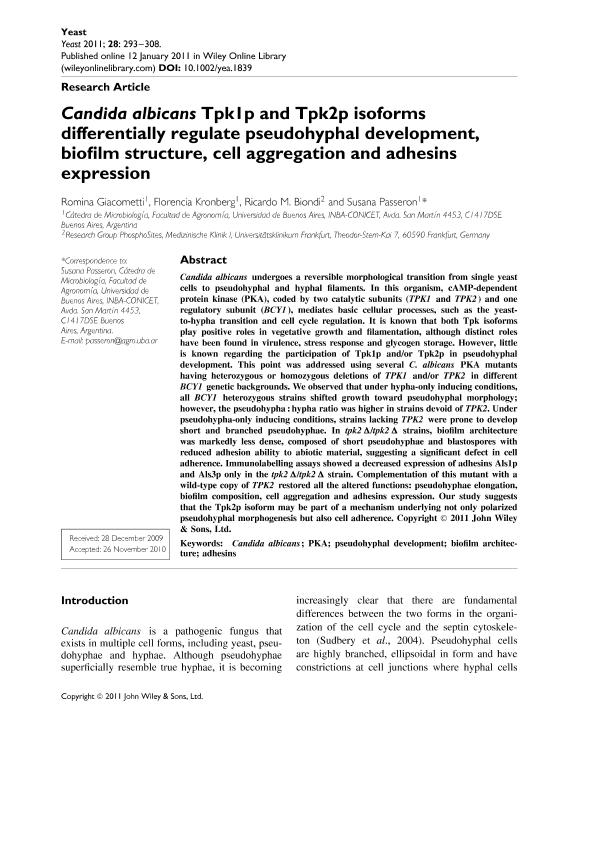Mostrar el registro sencillo del ítem
dc.contributor.author
Giacometti, Romina

dc.contributor.author
Kronberg, Maria Florencia

dc.contributor.author
Biondi, Ricardo Miguel

dc.contributor.author
Passeron, Susana
dc.date.available
2018-09-20T22:28:44Z
dc.date.issued
2011-04
dc.identifier.citation
Giacometti, Romina; Kronberg, Maria Florencia; Biondi, Ricardo Miguel; Passeron, Susana; Candida albicans Tpk1p and Tpk2p isoforms differentially regulate pseudohyphal development, biofilm structure, cell aggregation and adhesins expression; John Wiley & Sons Ltd; Yeast; 28; 4; 4-2011; 293-308
dc.identifier.issn
0749-503X
dc.identifier.uri
http://hdl.handle.net/11336/60550
dc.description.abstract
Candida albicans undergoes a reversible morphological transition from single yeast cells to pseudohyphal and hyphal filaments. In this organism, cAMP-dependent protein kinase (PKA), coded by two catalytic subunits (TPK1 and TPK2) and one regulatory subunit (BCY1), mediates basic cellular processes, such as the yeast-to-hypha transition and cell cycle regulation. It is known that both Tpk isoforms play positive roles in vegetative growth and filamentation, although distinct roles have been found in virulence, stress response and glycogen storage. However, little is known regarding the participation of Tpk1p and/or Tpk2p in pseudohyphal development. This point was addressed using several C. albicans PKA mutants having heterozygous or homozygous deletions of TPK1 and/or TPK2 in different BCY1 genetic backgrounds. We observed that under hypha-only inducing conditions, all BCY1 heterozygous strains shifted growth toward pseudohyphal morphology; however, the pseudohypha:hypha ratio was higher in strains devoid of TPK2. Under pseudohypha-only inducing conditions, strains lacking TPK2 were prone to develop short and branched pseudohyphae. In tpk2Δ/tpk2Δ strains, biofilm architecture was markedly less dense, composed of short pseudohyphae and blastospores with reduced adhesion ability to abiotic material, suggesting a significant defect in cell adherence. Immunolabelling assays showed a decreased expression of adhesins Als1p and Als3p only in the tpk2Δ/tpk2Δ strain. Complementation of this mutant with a wild-type copy of TPK2 restored all the altered functions: pseudohyphae elongation, biofilm composition, cell aggregation and adhesins expression. Our study suggests that the Tpk2p isoform may be part of a mechanism underlying not only polarized pseudohyphal morphogenesis but also cell adherence.
dc.format
application/pdf
dc.language.iso
eng
dc.publisher
John Wiley & Sons Ltd

dc.rights
info:eu-repo/semantics/openAccess
dc.rights.uri
https://creativecommons.org/licenses/by-nc-sa/2.5/ar/
dc.subject
Adhesins
dc.subject
Biofilm Architecture
dc.subject
Candida Albicans
dc.subject
Pka
dc.subject
Pseudohyphal Development
dc.subject.classification
Otras Ciencias Biológicas

dc.subject.classification
Ciencias Biológicas

dc.subject.classification
CIENCIAS NATURALES Y EXACTAS

dc.title
Candida albicans Tpk1p and Tpk2p isoforms differentially regulate pseudohyphal development, biofilm structure, cell aggregation and adhesins expression
dc.type
info:eu-repo/semantics/article
dc.type
info:ar-repo/semantics/artículo
dc.type
info:eu-repo/semantics/publishedVersion
dc.date.updated
2018-09-12T19:11:32Z
dc.journal.volume
28
dc.journal.number
4
dc.journal.pagination
293-308
dc.journal.pais
Reino Unido

dc.journal.ciudad
Londres
dc.description.fil
Fil: Giacometti, Romina. Consejo Nacional de Investigaciones Científicas y Técnicas. Oficina de Coordinación Administrativa Parque Centenario. Instituto de Investigaciones en Biociencias Agrícolas y Ambientales. Universidad de Buenos Aires. Facultad de Agronomía. Instituto de Investigaciones en Biociencias Agrícolas y Ambientales; Argentina
dc.description.fil
Fil: Kronberg, Maria Florencia. Consejo Nacional de Investigaciones Científicas y Técnicas. Oficina de Coordinación Administrativa Parque Centenario. Instituto de Investigaciones en Biociencias Agrícolas y Ambientales. Universidad de Buenos Aires. Facultad de Agronomía. Instituto de Investigaciones en Biociencias Agrícolas y Ambientales; Argentina
dc.description.fil
Fil: Biondi, Ricardo Miguel. Universitätsklinikum Frankfurt; Alemania. Consejo Nacional de Investigaciones Científicas y Técnicas. Oficina de Coordinación Administrativa Parque Centenario. Instituto de Investigación en Biomedicina de Buenos Aires - Instituto Partner de la Sociedad Max Planck; Argentina
dc.description.fil
Fil: Passeron, Susana. Consejo Nacional de Investigaciones Científicas y Técnicas. Oficina de Coordinación Administrativa Parque Centenario. Instituto de Investigaciones en Biociencias Agrícolas y Ambientales. Universidad de Buenos Aires. Facultad de Agronomía. Instituto de Investigaciones en Biociencias Agrícolas y Ambientales; Argentina
dc.journal.title
Yeast

dc.relation.alternativeid
info:eu-repo/semantics/altIdentifier/doi/http://dx.doi.org/10.1002/yea.1839
dc.relation.alternativeid
info:eu-repo/semantics/altIdentifier/url/https://onlinelibrary.wiley.com/doi/abs/10.1002/yea.1839
Archivos asociados
